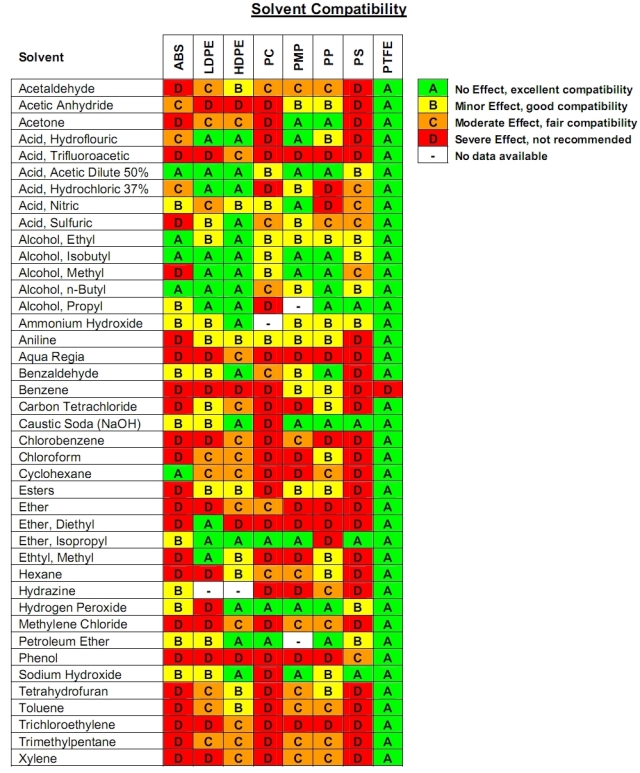While recently trying to apply my limited chemistry knowledge to work out which solvents will dissolve ABS (and failing miserably) I came across the handy table shown below. It depicts which solvents will effect a range of thermoplastics and is otherwise self explanatory. I can only assume that “No effect” means that its safe to store the solvent in a container made of that particular plastic.
PLA is not shown but its fair to assume it would be highly susceptible to most of the solvents listed, but again, I’m no chemist.
Now if only it was practical to use PTFE filament feedstock, then I could one day print my own chemistry set!
Just a word of warning, most of the solvents on the list above are highly volatile, flammable and toxic. So please read the relevant MSDS before handling any solvent!
The original pdf file can be found here.



Hi, I was trying to find info on PLA. Did you find any information on solvents in the mean time? If I do, I’ll report back to you. I’ve been asking in various places 🙂
Hi Erik
A quick google suggests that PLA is soluble in Dichloromethane, (source) which I believe is found in some common pain strippers. So that could be a starting point worth trying.
I would be interested to hear how you go!
Dichloromethane is in epoxy remover along with methanol. Methanol has a MUCH higher vapor pressure, so you could probably just let is sit out of you wanted to get rid of the alcohol in it (which I don’t know effects the solubility or not). Obviously do this in an OPEN area without flames or sparks.
In my experience, diethyl ether is one of the best common plastic solvents but I think it’s pretty hard to get. It’s in starter fluid but along with a bunch of other crap (mostly petroleum distillates I believe).
Tetrachloroethylene (which should have solvent properties pretty similar to tri-) can be found in Brakleen, a type of break cleaning fluid you can find at auto parts stores. You gotta look at the ingredients though — there are 2 kinds and one is the wrong type.
Hi RabidRick
Thanks for the information, looks quite useful! I will keep an eye out for Brakleen next time in an an auto store.
Richard.
No prob! I’m dealing with the same stuff, myself. Actually, I just found out how to get the black stuff off this ribbon cable I’m dealing with. Acetone did close to nothing but simple 92% IPA bath from Walgreens did the trick! Then underneath, there’s still a layer of (what I think) is still thermoplastic >..<
I'm just trying to test LVDS display panels (LCD).
can someone please tell me what is the general solvent used to dissolve plastic
When you say “plastic” you need to know which type you want to dissolve. There are so so so many types of plastic. Look up the word “plastic” and you’ll see it is a very general term. The chart above indicates 8 primary types of plastic…for example using the chart above you should be able to see quite clearly that no ONE solvent dissolves ALL plastics listed. Diethyl Ether will dissolve 6 out of 8 and Benzine will dissolve 6 of 8 but 2 will dissolve just a bit over time. This chart clearly and easily tells you your answer. Find out the type of plastic you want to dissolve….then use this chart to find the solvent you need. Cheers.